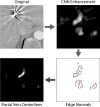Combining deep learning with anatomical analysis for segmentation of the portal vein for liver SBRT planning
- PMID: 28994665
- PMCID: PMC5739057
- DOI: 10.1088/1361-6560/aa9262
Combining deep learning with anatomical analysis for segmentation of the portal vein for liver SBRT planning
Abstract
Automated segmentation of the portal vein (PV) for liver radiotherapy planning is a challenging task due to potentially low vasculature contrast, complex PV anatomy and image artifacts originated from fiducial markers and vasculature stents. In this paper, we propose a novel framework for automated segmentation of the PV from computed tomography (CT) images. We apply convolutional neural networks (CNNs) to learn the consistent appearance patterns of the PV using a training set of CT images with reference annotations and then enhance the PV in previously unseen CT images. Markov random fields (MRFs) were further used to smooth the results of the enhancement of the CNN enhancement and remove isolated mis-segmented regions. Finally, CNN-MRF-based enhancement was augmented with PV centerline detection that relied on PV anatomical properties such as tubularity and branch composition. The framework was validated on a clinical database with 72 CT images of patients scheduled for liver stereotactic body radiation therapy. The obtained accuracy of the segmentation was [Formula: see text] 0.83 and [Formula: see text] 1.08 mm in terms of the median Dice coefficient and mean symmetric surface distance, respectively, when segmentation is encompassed into the PV region of interest. The obtained results indicate that CNNs and anatomical analysis can be used for the accurate segmentation of the PV and potentially integrated into liver radiation therapy planning.
Figures








References
-
- Siegel RL, Miller KD, Jemal A. Cancer Statistics, 2017. CA. Cancer J. Clin. 2017 Jan;67(1):7–30. - PubMed
-
- Høyer M, et al. Radiotherapy for liver metastases: a review of evidence. Int. J. Radiat. Oncol. Biol. Phys. 2012 Mar;82(3):1047–1057. - PubMed
-
- Lee MT, et al. Phase I study of individualized stereotactic body radiotherapy of liver metastases. J. Clin. Oncol. Off. J. Am. Soc. Clin. Oncol. 2009 Apr;27(10):1585–1591. - PubMed
-
- Toesca DAS, et al. Central liver toxicity after SBRT: An expanded analysis and predictive nomogram. Radiother. Oncol. 2016 Nov; - PubMed
-
- Osmundson EC, Wu Y, Luxton G, Bazan JG, Koong AC, Chang DT. Predictors of toxicity associated with stereotactic body radiation therapy to the central hepatobiliary tract. Int. J. Radiat. Oncol. Biol. Phys. 2015 Apr;91(5):986–994. - PubMed
MeSH terms
Grants and funding
LinkOut - more resources
Full Text Sources
Other Literature Sources
Medical
Miscellaneous
